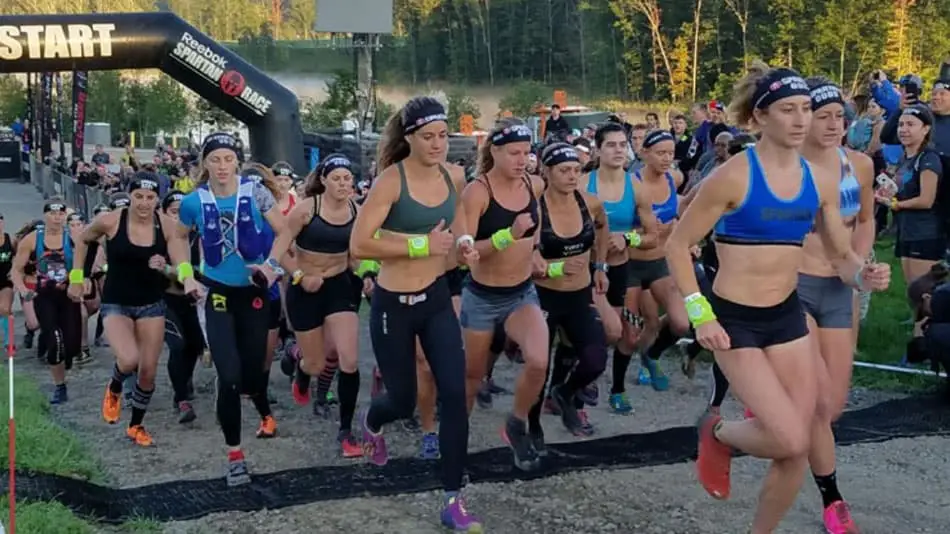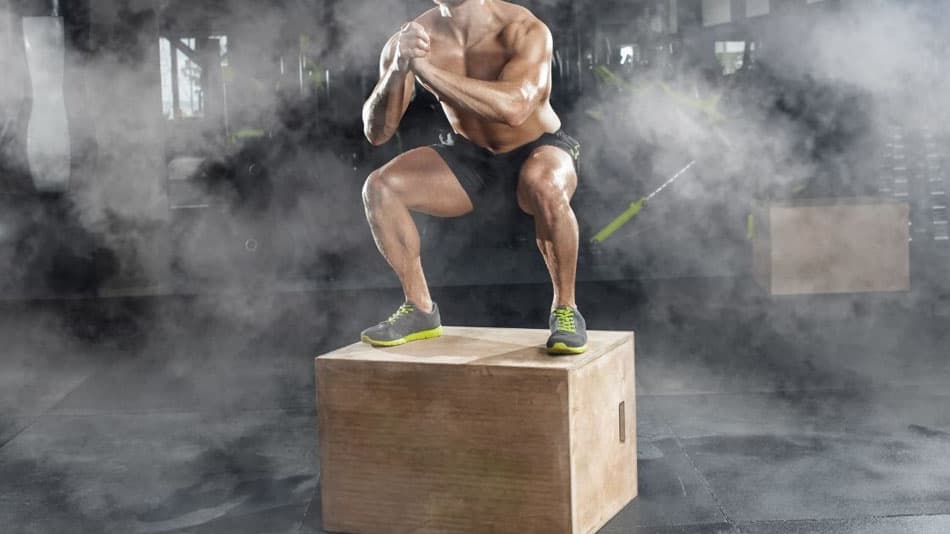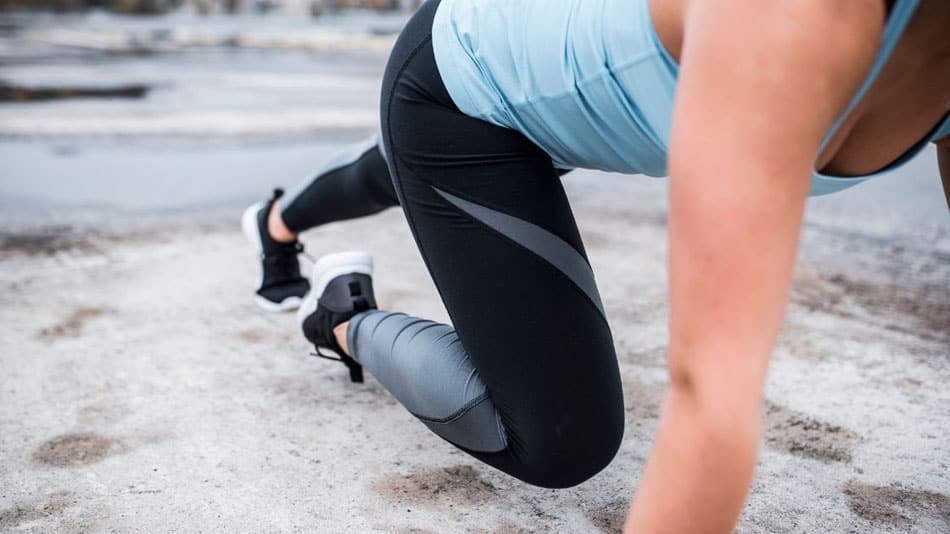
With about 10 miles to traverse that are full of muddy pits, climbing walls, and fire jumping, a mud run will leave you completely and utterly exhausted.
This is not an athletic event you can walk into with minimal training and expect to do well. You should try hitting the gym regularly, gearing up for your first mud run. What kinds of exercises should you do?
I recommend the following exercises to conquer your first mud run:
- Burpees
- Spider push-ups
- Squats
- Lunges
- Step-ups
- Box jumps
- Pull-ups
- Sit-ups
- Bear crawls
- Planks
- Mountain climbers
- Broad jumps
- Ski jumps
- Single-leg calf raises
After participating in many mud run races through the years, I’ve gained some experience by doing and trying different exercises. These bodyweight exercises are my go-to training regimen for a complete body workout. They will make you strong and ready to tackle any mud run or strenuous activity the world throws at you.
Start with Burpees
It’s no coincidence that I’ve put burpees in the number-one spot. Even if you decide not to read any further (which I’m sure you won’t!). This is the one exercise you should implement into your workout routine ahead of your first mud run.
Why Burpees?
As you will soon find out once you begin doing them, burpees are a rather brutal exercise. Your entire body is put to work, your muscles coming alive in a matter of seconds, especially your arms, back, core, and legs. Burpees are also a great form of cardio. That’s why they’re utilized in many high-intensity interval training or HIIT workout training programs.
How to Burpee
· Stand straight. Open your feet to shoulder-width.
· Squat down with proper form.
· From the squat position, place your arms in front of you and then kick both legs back into a plank position.
· Maintaining a straight back, do a push-up.
· Jump your feet back into a squat.
· Perform a jump.
Burpee Variations
· Pull-up burpee
· One-leg burpee
· Reverse burpee
· Broad jump burpee
· Burpee to box jump

Next, Do Spider Push-ups
There are regular push-ups (which I do recommend), and then there are spider push-ups. Since a mud run demands you to use your body in many unique ways, incorporating more than the basic push-up into the beginning of your routine is a smart move.
Why Spider Push-ups?
Spider push-ups can improve your range of motion, which is just what you’re looking for when competing in a mud run.
If you need more anti-rotational core strength, these push-ups are the way to go. As you move your body towards the leg that’s coming out during the spider push-up, your core muscles keep your body stabilized. Doing so, due to the rotation of your legs, makes the core work more. Although this seems like a bad thing, you may safeguard your back from injuries if you do enough spider push-ups.
More of your muscles come into play when doing spider push-ups too!
How to Do a Spider Push-up
- Place a mat on the floor and position your hands, further out on the mat, then your shoulders. Keep your feet together and put your weight on the balls of the feet.
- Taking a deep breath and keeping your back straight, go down until your arms are 90 degrees.
- Starting with your right side, bend your knee, then move it forward and out towards your elbow on that side.
- Release your breath, allowing your knee and elbows to extend. This should put you back in the position you were in when you started.
- Repeat on the other side.
Spider Push-up Variations
- Regular push-ups
- Hindu push-ups
- Walking push-ups
Continue with Squats
In his book Power Training , coach Robert dos Remedios named squats “the king of all lower back exercises.” That’s for a good reason, too! Every time you perform a proper squat, several muscles are at work.
, coach Robert dos Remedios named squats “the king of all lower back exercises.” That’s for a good reason, too! Every time you perform a proper squat, several muscles are at work.
Why Squats?
According to Healthline , the muscles you target as you squat include the glutes, quadriceps, hamstrings, adductors, hip flexors, calves, lower back, and core. That’s why this exercise is a must-do in your mud run workout routine.
, the muscles you target as you squat include the glutes, quadriceps, hamstrings, adductors, hip flexors, calves, lower back, and core. That’s why this exercise is a must-do in your mud run workout routine.
How to Squat
· Place your feet shoulder-width apart.
· Lower your hips down as far as you can (safely).
· Raise to the top.
· Repeat.
Squat Variations
· Sumo squat
· One leg-squat
· Jumping squat
· Wall sit
Do Some Lunges
Lunges are one of the best single-leg exercises, period. If you have been to a Spartan-free workout, then you know how much they like lunges. As a runner, this is a great exercise that will increase your performance while helping you stay injury-free. The idea is always to do functional exercises that mimic the conditions of your race or daily life. As a runner, doing single-leg exercises will be monumental in your development. For all other exercisers, I recommend lunges as well.
Why Lunges?
Fit & Me says that, through doing lunges, you can strengthen and tone your glutes, hamstrings, calves, and other leg muscles. You may also notice that your coordination improves, your spine is healthier, and you’re more flexible and balanced. Oh, and your butt will look better too.
says that, through doing lunges, you can strengthen and tone your glutes, hamstrings, calves, and other leg muscles. You may also notice that your coordination improves, your spine is healthier, and you’re more flexible and balanced. Oh, and your butt will look better too.
How to Lunge
- Stand up straight, then extend your foot in front of you, so your leg is at a precise 90-degree angle. Your knee should be in-line with your toes.
- Keep your other leg at a parallel angle from the floor or ground.
- Return your leg to the original starting position and repeat about 10 times on that leg. You can also lunge once per leg and complete your reps that way.
Lunge Variations
- Walking lunge
- Pendulum lunge
- Goblet forward lunge
- Slider reverse lunge
Train with Step-ups
Step-ups are the first exercise I’m recommending that requires some equipment, ideally a set of stairs. However, if all you have is a small plastic platform or a step stool, either of those should suffice. You could even do step-ups on your front porch or on a park bench if you wanted to!
Why Step-ups?
Remember what I said in the intro? Some mud runs are 10 miles long. You’ll need plenty of leg strength to get through the day, and step-ups will definitely help. You can also improve your vertical jump height, so completing some of the mud run obstacles won’t be as big a deal anymore.
Since step-ups don’t require you to use as much body weight as you do when squatting, you might reduce your risk of lower back and knee injuries, notes Prescription Fitness .
.
How to Do Step-ups
- Begin by positioning one foot on the steps. Alternately, a chair or bench works.
- Use the heel of your foot for grounding as you put that foot upon the step.
- Put the other foot on the step as well.
- Take one foot down at a time, then repeat by stepping with the other foot.
Step-up Variations
- Explosive step-ups
- Single-leg squat step-ups
- Barbell step-ups
- High-box step-ups
- Later step-ups
- Goblet step-ups
- Aerobic step-ups

Get Moving with Box Jumps
Now that your bottom half is feeling nice and limber after your step-up routine continue that momentum with some box jumps. The difference between step-ups and box jumps is that you’re stepping up with one foot at a time with the latter. Box jumps require you to jump up with both feet. The height of your jumps will also be greater with a box jump.
Why Box Jumps?
Box jumps continue working your lower body, especially your glutes and quads. Although considered a high-impact exercise, box jumps shouldn’t lead to injury if you do them properly. Between the power you’ll develop in your lower body as well as the rate of building muscles, you’ll want to do box jumps even when you’re not training for a mud run!
How to Box Jump
- Get a box or platform that’s at least 20 inches tall. At the very beginning, you may want to halve that height so you can do more box jumps successfully.
- Position your body, so you’re centered to the box.
- Space out your feet, so they’re at the width of your shoulders.
- Bend down until you’re in a quarter-squat, swinging your arms first back, then forward.
- Jump up and try not to put too much force on the box with your landing.
Box Jump Variations
- One-step box jump
- Single-leg box jump
- Weighted box jump
- Static box jump
- Countermovement box jump
Do Some Traditional Pull-ups
Since I’m sure you’re at least relatively athletically-inclined (that’s why you’re reading this article), I can say with confidence that you’ve done some pull-ups before. That’s good, as they’re an integral part of your mud run routine.
Pull-ups will give your bottom half a much-needed break for a little while as you focus more on your upper half during this part of the regimen.
Why Pull-ups?
Doing pull-ups is excellent for your health for all sorts of reasons. Healthline says you’ll have better grip strength doing pull-ups that will come in handy for engaging in many other sports and activities.
says you’ll have better grip strength doing pull-ups that will come in handy for engaging in many other sports and activities.
For instance, if you go bowling or rock-climbing, you lift weights, or you play tennis or golf, you may notice your performance improves thanks to all those pull-ups you’ve been doing.
You also work very specific back muscles that you maybe don’t hone in on by doing other exercises. These muscles include the infraspinatus (for healthy shoulder movement), the thoracic erector spinae, the trapezius, and the latissimus dorsi (the biggest muscle in the upper back).
How to Do Pull-ups
- Position yourself under your pull-up bar.
- Take a deep breath, tensing the muscles in your upper body.
- Bend the elbows and grab the bar, pulling yourself up.
- Stop moving up when your chin is up past the bar (not hitting the bar!).
- Take another breath, then bring yourself back down.
- Repeat.
Pull-up Variations
- Behind-the-neck pull-ups
- Tandem grip pull-ups
- Archer pull-ups
- Single-arm pull-ups
- Mixed grip pull-ups
- L-sit pull-ups
- Towel grip pull-ups
- Wide-grip pull-ups
Add Sit-ups to Your Routine
Once you’re done doing pull-ups, transition to sit-ups. You’re still giving your lower half a rest and activating all the muscles throughout the upper half of your body with sit-ups, among them your hips, abs, and core.
Why Sit-ups?
Sit-ups, despite being a relatively basic exercise, are rife with benefits. You can strengthen your diaphragm, so deep breathing comes easier. Considering many of the exercises I’ve suggested to this point are dependent on deep breathing, you’ll get more out of your whole mud run workout.
You can also improve your posture, flexibility, stability, and balance through sit-ups while building muscle and core strength.
How to Do Sit-ups
- Place a floor mat and lay down flat on it, bending your knees.
- Put your hands behind your head or across your shoulders.
- Raise your body up until your shoulders are well off the ground. Release your breath as you lift up.
- Lie back down and repeat.
Sit-up Variations
- Side stability ball crunch sit-ups
- Raised leg crunches
- Scissor sit-ups
- Dead bug sit-ups
- V-ups
- Russian twist sit-ups
- Reverse crunches
Next, Do Bear Crawls
To ready your body for the rock-climbing part of your mud run, bear crawls are a fantastic exercise to incorporate. If you’ve done baby crawls before, bear crawls are not the same. You’re not using your knees to bear the brunt of your weight, but the toes and hands instead.
Why Bear Crawls?
For better stability and core functioning, bear crawls can’t be beaten. You’ll work your chest, shoulders, and arms, increasing endurance across your upper half. You also activate the serratus anterior by doing bear crawls, which is a rib muscle.
How to Bear Crawl
- Position yourself, so you’re on your fours. Your knees should be at 90 degrees.
- Push forward with one hand, using the foot opposite that hand to keep your balance.
- Then move forward with the other side of your body.
Bear Crawl Variations
- Straight bear crawl
- Low bear crawl
- Fast bear crawl
- Relaxed bear crawl
- Slow bear crawl

Practice Your Planks
Compared to the other exercises in this regimen so far, planks can seem like a walk in the park, well, until you need to hold the position for seconds at a time, even a minute or two. Then your limbs may begin wobbling, and your muscles will scream, but that’s a good thing! It means you’re using your muscles in new ways.
Why Planks?
Yes, you’ll get core strength from planks, but that’s not all. Your trapezius, rhomboids, glutes, and quads will be stronger as well. You may improve spinal strength and improve your posture with planks.
Oh, and even better is that you can do planks anytime, anywhere, as long as you have a flat surface beneath you. That makes training for your mud run more convenient!
How to Plank
- Choose a flat surface to start on.
- Position your hands, so they’re under your shoulders, sort of like doing a push-up.
- Balance on your toes, keeping your lower half straight.
- Stay in the position for at least 20 seconds to start, then gradually increase the time spent in the pose.
Plank Variations
- Medicine ball plank
- Single-leg plank
- Side plank
- Knee plank
- Forearm plank
Work Your Bottom Half with Mountain Climbers
Catch your breath, as it’s time to continue with some mountain climbers. After doing bear crawls, transitioning to mountain climbers should be easy.
You’re back to working your lower half, which you didn’t engage with as much when doing planks, but you should be ready by now.
Why Mountain Climbers?
Mountain climbers are considered low-impact, so you can add them to your training routine even on those days when you don’t want to overexert yourself. By doing mountain climbers, you can improve your flexibility, core strength, upper body power, and even benefit your heart.
If you have some leftover belly fat you’re trying to work off, mountain climbers are a beloved exercise for flattening your tummy.
How to Do Mountain Climbers
- Start like you did when doing a plank.
- Then, raise one foot towards the same hand, putting the opposite foot out behind.
- Switch quickly and seamlessly, repeating the motion.
Mountain Climber Variations
- Plank jack mountain climbers
- Back plank mountain climbers
- Standing mountain climbers
- Cross-body mountain climbers
- Army crawl mountain climbers
- Tricep mountain climbers
- TRX mountain climbers
Get Moving with Broad Jumps
Broad jumps, also referred to as long jumps, are a track and field exercise. Although there’s no way to avoid getting dirty during a mud run (seriously, where do you think the name comes from?). The longer your jumps, the easier it will be to leap through the course and get a bit less muddy.
Why Broad Jumps?
Broad jumps will teach you better balance and boost your acceleration speed. If you’re a younger mud runner, you may be able to spare your bone density through broad jumps. The power and strength of your legs will be better than ever.
How to Do Broad Jumps
- Choose a target to reach with your jump.
- Position your arms, so they’re swinging behind you. Aim your fingers low.
- Move your hips back while you bend at the knees.
- Jump, projecting yourself forward as you do.
- Measure your jumping distance.
Broad Jump Variations
- Two-way broad jumps
- Rebound broad jumps
- Cannonball chasers
Do Some Ski Jumps Next
No, you’re not entirely done jumping yet. Once you get your broad jumps down, transitioning to ski jumps should be exceedingly simple. A ski jump is all about the length of your jumps, which you’re trying to perfect.
By the way, I’m not saying you need to strap on a pair of skis and hit the slop to do a ski jump. No, no, not at all. You can do this maneuver from the safety of your home or your gym, your choice!
Why Ski Jumps?
Just like broad jumps, as you jump across obstacles during your mud run, ski jumps will clear more distance. Your proprioception and balance are bettered for jumping this way, and you may improve joint stability across the lower half of your body, such as the ankles, knees, and hips.
Some ski jumpers say you can reduce your injury risk with this exercise too.
How to Do Ski Jumps
- Bend yourself at the waist as though you were skiing for real.
- Move your arms back and behind you, bending the elbows at 90 degrees.
- Jump from one side, then another.
Ski Jump Variations
- Broad jumps
- Squat jumps
- Box jumps

End Your Routine with Single-Leg Calf Raises
You’ve almost made it to the finish line now! Complete your workout for the day with a set of single-leg calf raises, an excellent low-impact exercise to do last.
Why Single-Leg Calf Raises?
When trying to look burlier or ripped, you probably don’t focus as much on your calf muscles, but you should. When you do broad jumps or ski jumps, having calf strength will increase your jumping agility. The same is true if you’re a runner.
You can also safeguard your soleus and gastrocnemius from injuries, including joint strain and other nagging pain. You may have a better balance as well.
How to Do Single-Leg Calf Raises
- With a dumbbell in one hand, lift the foot on the same side onto an incline bench or a similar surface.
- Your opposite ankle should bend behind the ankle that’s lifted. Use your free hand to maintain your balance.
- The foot that’s in the air might begin to lower, so raise it now and squeeze.
- Return both legs to the floor and then repeat on the other side.
Single-Leg Calf Raises Variations
- Leg press calf raise
- Double-legged standing calf raise
- Seated calf raise
Conclusion
Mastering your first mud run will not be easy, but I fully believe it’s possible with these exercises. Remember also to care for yourself in other ways, such as maintaining a nutritious, clean diet and getting plenty of sleep. Best of luck and I will see you on the course.

